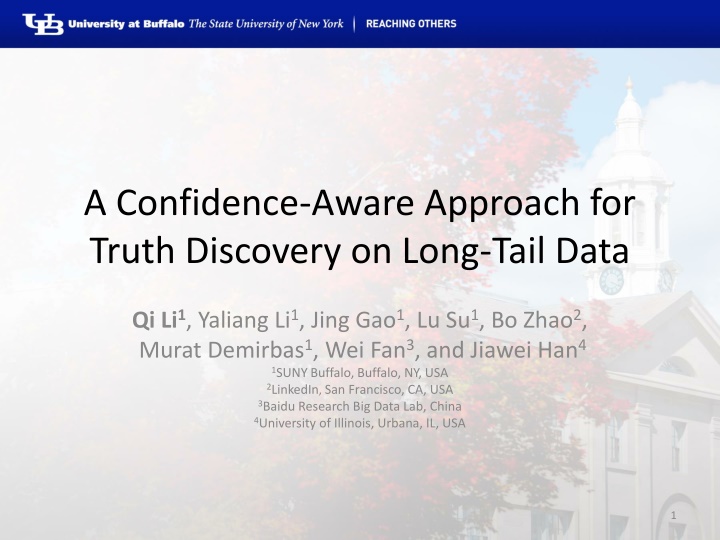
Confidence-Aware Truth Discovery for Long-Tail Data Aggregation
The paper presents a confidence-aware approach for truth discovery on long-tail data by aggregating information from diverse sources while considering source reliability. It tackles challenges in truth discovery such as source correlations, source costs, and streaming data. The method infers both truth and source reliability, emphasizing that a source is reliable if it provides many true pieces of information. Existing works are discussed, highlighting limitations when most sources make few claims. The overview emphasizes the importance of estimating source reliability along with confidence intervals in the aggregation process.
Download Presentation

Please find below an Image/Link to download the presentation.
The content on the website is provided AS IS for your information and personal use only. It may not be sold, licensed, or shared on other websites without obtaining consent from the author. If you encounter any issues during the download, it is possible that the publisher has removed the file from their server.
You are allowed to download the files provided on this website for personal or commercial use, subject to the condition that they are used lawfully. All files are the property of their respective owners.
The content on the website is provided AS IS for your information and personal use only. It may not be sold, licensed, or shared on other websites without obtaining consent from the author.
E N D
Presentation Transcript
A Confidence-Aware Approach for Truth Discovery on Long-Tail Data Qi Li1, Yaliang Li1, Jing Gao1, Lu Su1, Bo Zhao2, Murat Demirbas1, Wei Fan3, and Jiawei Han4 1SUNY Buffalo, Buffalo, NY, USA 2LinkedIn, San Francisco, CA, USA 3Baidu Research Big Data Lab, China 4University of Illinois, Urbana, IL, USA 1
50% 30% 19% 1% A B C D Which of these square numbers also happens to be the sum of two smaller square numbers? 16 25 36 49 2 https://www.youtube.com/watch?v=BbX44YSsQ2I
50% 30% 19% 1% A B C D Which of these square numbers also happens to be the sum of two smaller square numbers? 16 25 36 49 3 https://www.youtube.com/watch?v=BbX44YSsQ2I
Problem Description Our task is to aggregate the information from different sources for the same entities by considering source reliability degrees. Truth Discovery 4
Truth Discovery Principle Infer both truth and source reliability from the data A source is reliable if it provides many pieces of true information A piece of information is likely to be true if it is provided by many reliable sources 5
Existing Work Existing methods Tackle different challenges in truth discovery Source correlations, source costs, streaming data, Limitation when most sources make a few claims Sources weights are proportional to the accuracy of the sources When the number of claims from a source is quite small, the estimation of the accuracy is unreliable. 7
Overview of Our Work A confidence-aware approach not only estimates source reliability but also considers the confidence interval of the estimation 8
Aggregation Assume that each source has a weight ?? To aggregate the various information, weighted combination is adopted: ? ???? ?? ? = ?? ? ???? 9
Model the Error Distribution Assume that sources are independent Error made by source ?: ?? ? 0, ??2 ? ????? ? ???, we have Since ????????= ???????? ? 0, ? ???2??2 2 ? ??? Without loss of generality, we constrain ? ???= 1 10
Minimize the Variance of Errors Goal: want the variance of ????????to be as small as possible Optimization 11
How to Estimate Variance We can estimate the variance of each source using similar formulation for sample variance: 1 ?? ? ?? where ?? (0)2 ??2= ? ?? ?? (0) is the initial truth. 12
Estimate CI of Variance The estimation is not accurate with small number of samples. Find a range of values that can act as good estimates. Calculate confidence interval based on ?? ??2 ??2 ?2?? 13
Example Example on calculating confidence interval 14
Example Example on calculating confidence interval 15
Example Example on calculating confidence interval 16
How to estimate variance Consider the possibly worst scenario of ??2 Use the upper bound of the 95% confidence interval of ??2 2 0 ? ?? ? ???? 2= ?? 2 ?0.05, ?? 17
CATD Closed-form solution: 2 ?0.05, ?? 1 ?? ?? 2= 2 0 ? ?? ? ???? 18
Example Example on calculating source weight 19
Example Example on calculating source weight 20
Example Example on calculating source weight 21
Performance on Game Data Question level Majority Voting CATD 1 0.0297 0.0132 2 0.0305 0.0271 3 0.0414 0.0276 4 0.0507 0.0290 5 0.0672 0.0435 6 0.1101 0.0596 7 0.1016 0.0481 8 0.3043 0.1304 9 0.3737 0.1414 10 0.5227 0.2045 22
Performance on Game Data Comparison on Game dataset 23
Summary Truth Discovery on long-tail data Most sources only provide very few claims and only a few sources makes plenty of claims. By adopting effective estimators based on the confidence interval, CATD appropriately estimates source reliability for sources with different levels of participation. 24
